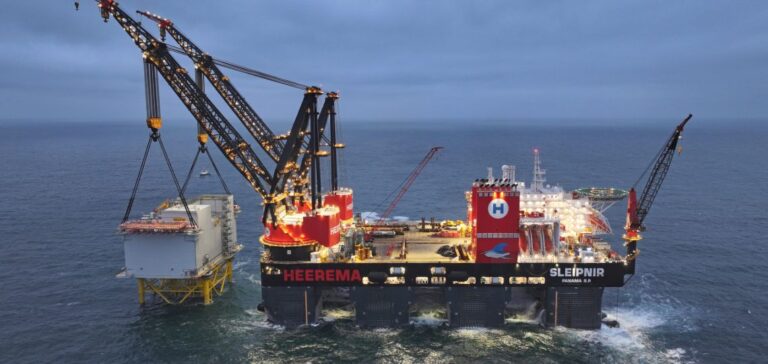The installation of the high-voltage direct current (HVDC) offshore converter platform for phase C of the Dogger Bank project has been completed, marking the finalisation of all three offshore substations for the wind farm. This technical milestone is part of the development of Dogger Bank Wind Farm, considered the largest offshore wind project currently under construction globally.
Installation completed by the Sleipnir vessel
The Dogger Bank C platform, supplied by Norwegian company Aibel and installed by Heerema Marine Contractors, measures approximately 75 metres by 50, with a height of 36 metres. It stands on a four-legged steel jacket foundation secured to the seabed at an average depth of 23 metres. The topside installation followed the safe placement of the jacket foundation one week earlier by the Sleipnir vessel.
According to Dogger Bank Wind Farm, the platforms are designed to be fully remotely operated from shore, with no permanent personnel onboard and accessible only by service operation vessels. The “lean” design introduced by Aibel enables a weight reduction of up to 70% for the topside compared to traditional platforms.
Three platforms to convert 3.6GW of power
Each of the three offshore platforms can receive up to 1.2GW of alternating current generated by the project’s wind turbines. This electricity is then converted into direct current by Hitachi Energy’s latest-generation HVDC converter technology, before being transmitted to three onshore converter stations located near Beverley in East Riding of Yorkshire and near Redcar on the Teesside coast.
Dogger Bank is the first offshore wind project in the United Kingdom to integrate this high-voltage conversion technology, enabling electricity to be transmitted efficiently over long distances while limiting energy losses.
Cross-company coordination on a complex site
Martijn Kuipers, Project Director for Dogger Bank C at Heerema, praised the coordination between field teams, industrial partners, and the Sleipnir crew, highlighting the ability to deliver complex offshore projects with precision.
Aibel, for its part, stated that the success of the operation was based on the strength of the partnership with Hitachi Energy and all project stakeholders. Additional commissioning activities will be carried out over the coming weeks to prepare the platforms for electricity transmission to the national grid.






















